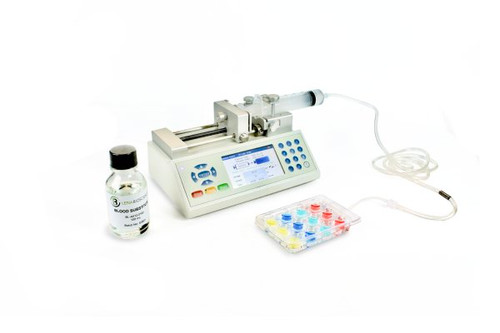

PerfusionPal provides physiologically relevant interstitial perfusion and superior oxygenation to 3D cell cultures cultured in the wells of a 12-well or a 48-well insert. This translates to enhanced cell viability and function for pharmaceutical, CRO, biotech and academic customers.
PerfusionPal’s superiority has been proven in weeks-long maintenance of complex primary models of brain and liver, for example, with remarkable outcomes resulting in two-fold to five-fold increase in cellular respiratory metabolism and log-fold increase in Phase I drug metabolism relative to 2D and 3D controls.
PerfusionPal enables seamless integration into routine workflow with superior outcomes in both short-term and long-term studies. It requires attachment of just one tube to perfuse 48 statistically independent organ models, all in their own media.
Drugs and assay reagents are added and removed as in any multiwell plate. Assays may be run in situ, supernatants transferred to another plate for plate reader readouts, and cultures removed and transferred to another dish for imaging.
Perfused Organ Panel is a unique system that enables continuous perfusion of 48 statistically independent organ cultures with just one tube. Media and assays are added and removed as in a standard 48-well plate. Scaffolds can be removed for cell isolation and imaging.
Starter system includes:
With the exception of syringe pump, all components are sterile.The blood substitute is immiscible with and insoluble in media, reagents, and drugs. Its main functions are to enable perfusion and provide superior gas exchange to the basal side of each culture. The blood substitute does not support the growth of microorganisms. It is the only chemical in the syringes and the tubing. The risk of contamination is therefore negligible compared to other perfusion platforms that utilize the culture media in tubing and syringes.
Benefits include:
What sets PerfusionPal apart from other "organ on a chip" products?
a. PerfusionPal is simple to setup and use. It requires attachment of one tube to perfuse 48 cultures.The use of blood substitute as a pumping liquid, eliminates the need for 48 pumps, 48 media bottles and 96 tubes that would otherwise be used in a 48-well organ-on-a-chip system.
b. In PerfusionPal, media, drugs and assay reagents are added and removed using micropipette as in any multiwall plate.In enclosed organs-on-a-chip, drugs are typically injected and removed through special ports with separate tubes or microfluidics; this is not trivial to do.
c. PerfusionPal has reliable and consistent performance. In contrast with other organ-on-a-chip technologies, in PerfusionPal there is no clogging of microchannels, no failures in operation, no need to service the system while running, and no drug adsorption to the interior of small channels contributing to uncertainty in drug concentration.
d. PerfusionPal is the only perfusion system with zero dead volume in fluidics. In PerfusionPal, media and drugs are not wasted in pumps, tubes, media bottles etc. as in all other perfusion technologies. Instead, media and drugs are added to the well and stay in the well during perfusion. This saves money in expensive developmental drugs and biologics.
e. PerfusionPal provides superior oxygenation and therefore, cellular function. This is an open system with two gas exchange interfaces; air at the top and blood substitute at the bottom of the culture. All other organ-on-a-chip and perfusion systems are generally enclosed and oxygen availability is low.
f. Biomarker discovery/ diagnostic and prognostic functions. In-well perfusion provides concentrated secretome, metabolome, and signalling molecules that may be concentrated enough to facilitate detection of new biomarkers of therapeutic efficacy or therapy surveillance.
Oops, something went wrong. Please try again.
You are now logged in!
